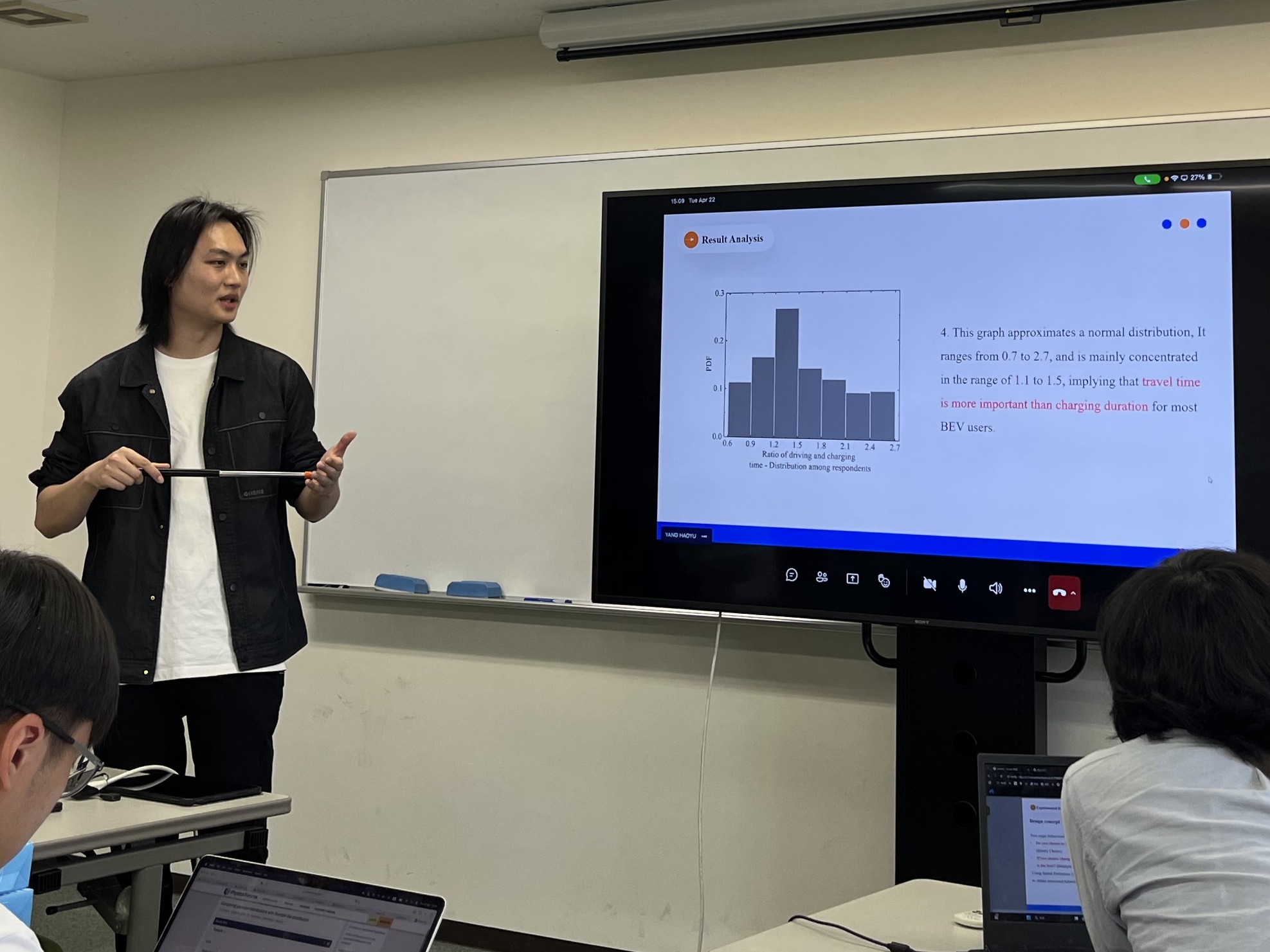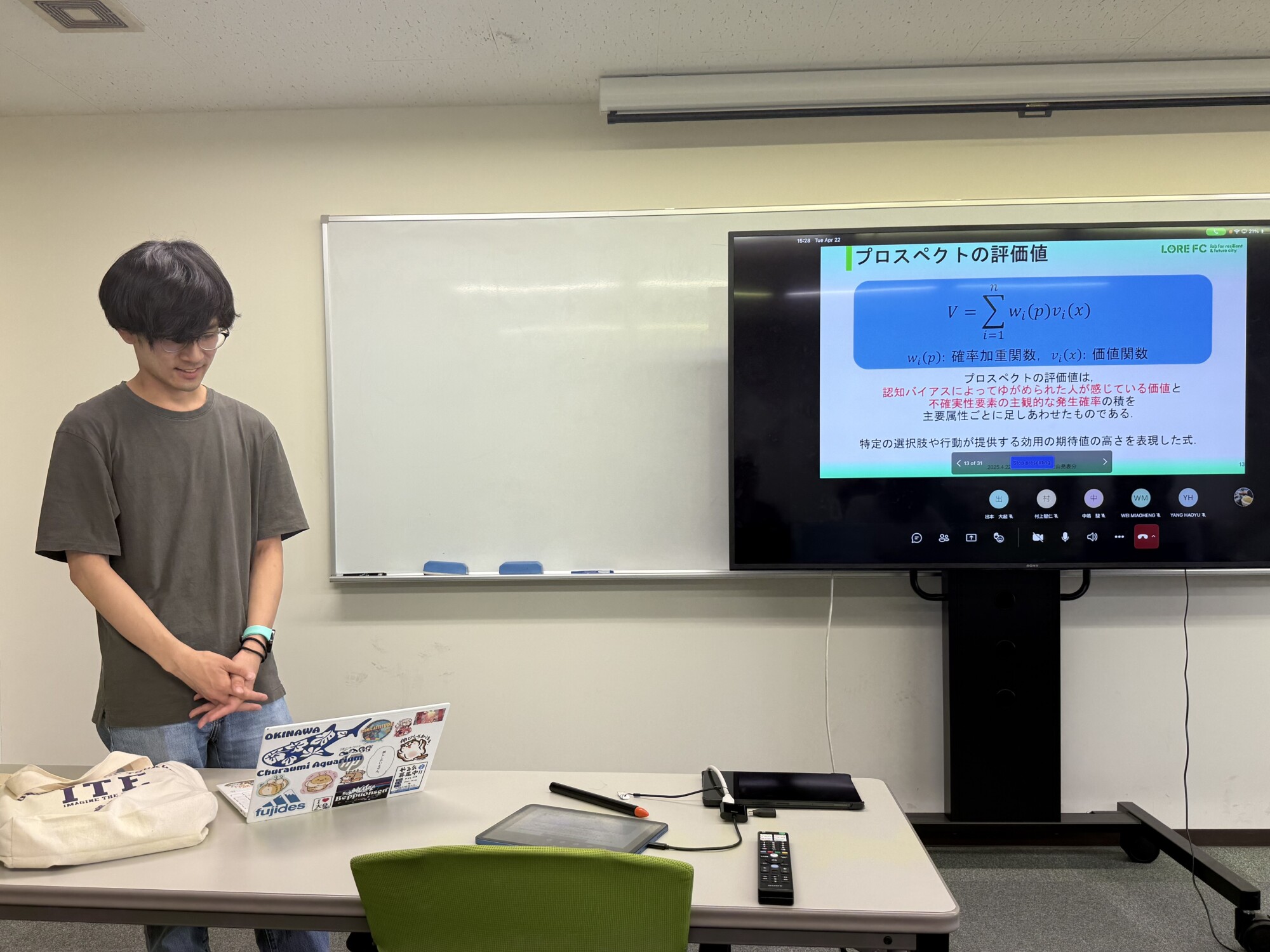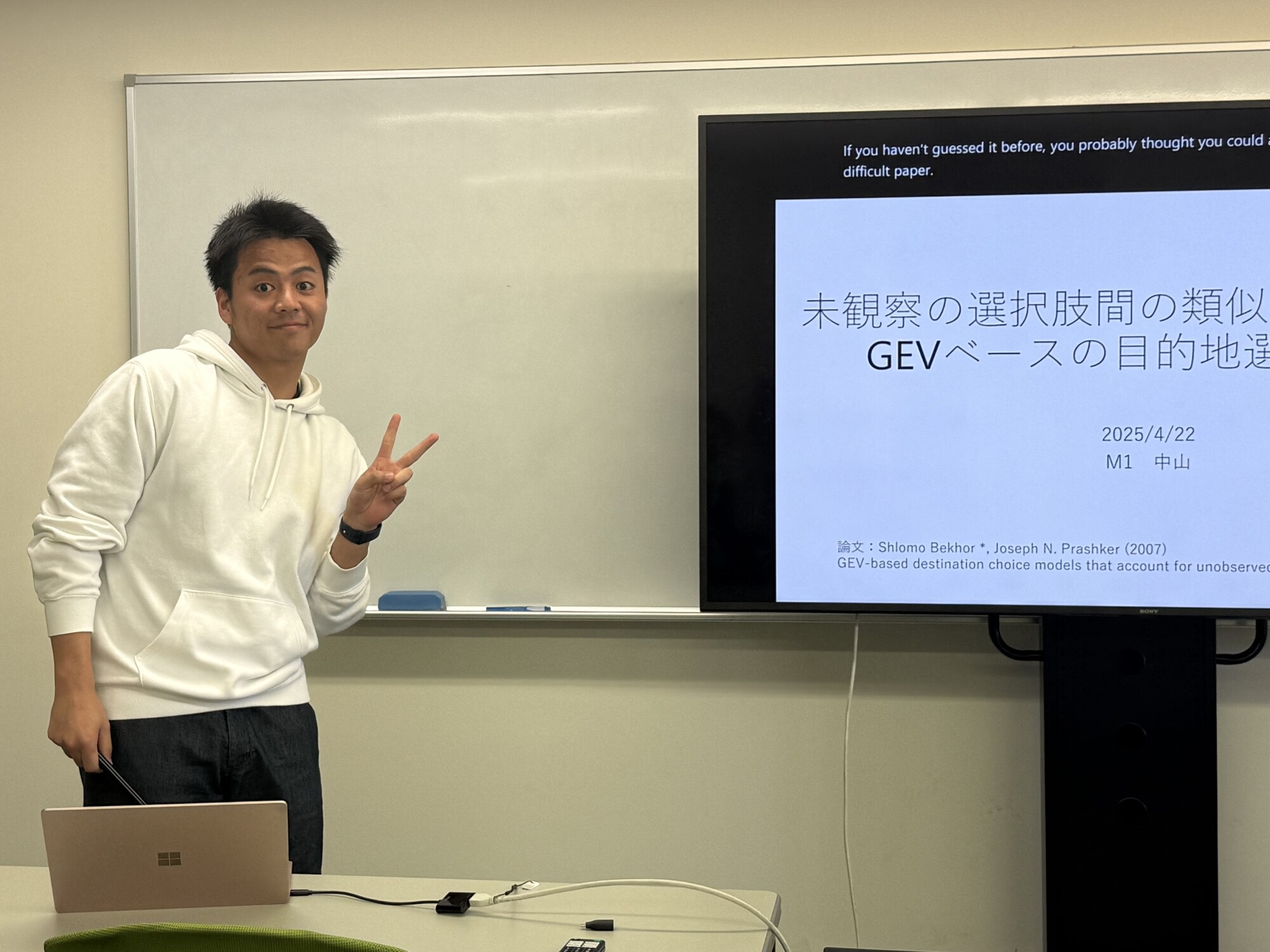

News
2025.04.22
朝晩はまだひんやりとした空気が残っていますが、日中は春の柔らかな暖かさを十分に感じられるようになりました。私たち学生同士の交流や豊かな発想を自然と後押ししてくれる、そんな心地良い毎日を過ごしています。
While there’s still a cool chill in the mornings and evenings, during the day we can fully enjoy the gentle warmth of spring. It’s such a pleasant time that it naturally fosters interaction and flexible thinking among us students.
さて、今回のゼミを担当したのは、M1Haoyuさん、M1上山さん、M1中山さんでした。
Today’s seminar was presented by Haoyu (M1), Kamiyama (M1), and Nakayama (M1).
M1Haoyuさんは、「Li et al. Uncertainty of available range in explaining the charging choice behavior of BEV users」に基づいて、AR(走行可能距離)の不確実性がEVユーザーの行動に影響することや、平均ARとAR不確実性を併せたモデルの優位性について発表しました。また、M1上山さんは、「Kahneman & Tversky, Prospect theory: An analysis of decision under risk」に基づいて、選択過程において期待効用理論に反する行動をモデル化したプロスペクト理論について発表しました。さらに、M1中山さんは、「Bekhor & Prashker, GEV-based destination choice models that account for unobserved similarities among alternatives」に基づいて、選択肢が複数のネストに属することを表現できるGNLモデルや、階層構造のNL-GNLモデルについて発表しました。
Haoyu presented based on Li et al.’s “Uncertainty of available range in explaining the charging choice behavior of BEV users,” discussing how uncertainty in the available range (AR) affects EV user behavior and the advantages of a model that combines mean AR with AR uncertainty. Kamiyama spoke on prospect theory, drawing on Kahneman & Tversky’s “Prospect Theory: An Analysis of Decision under Risk,” and showed how this theory models decision‑making behaviors that deviate from expected‑utility theory. Nakayama covered Bekhor & Prashker’s work on GEV‑based destination choice models that account for unobserved similarities among alternatives, presenting GNL models capable of representing alternatives in multiple nests as well as the newly proposed hierarchical NL‑GNL model.
今回のゼミ発表を担当した三人に、発表の内容をまとめてもらいました!
We asked these three presenters to summarize the key points of their presentations!
Haoyu:
This presentation introduces that AR (available range) and AR uncertainty play an important role in the charging decision-making process of EV users.
1. The uncertainty of AR significantly affects user behavior
– Even if the average AR is sufficient to complete the trip, users are more likely to choose charging when its fluctuation range (AR uncertainty) is large.
– Users are not only concerned about “average battery life” when making decisions, but also worry about “battery life risks”.
2. Time cost is always an influencing factor
– Whether it is the decision to charge or which route to choose, the total travel time (including charging) always has a strong negative utility.
– Users still tend to prioritize efficiency while ensuring security.
3. Individual heterogeneity exists in behavior
– The uncertainty sensitivity was set as a random variable in the model, and the results were significant.
– Indicating that different users have varying levels of tolerance for battery life uncertainty, with some being extremely conservative and others relatively bold.
4. The comprehensive model of “average AR + AR uncertainty ” is more explanatory
– If only the average AR is used as the decision variable, it will underestimate the actual behavioral preferences of users.
– Incorporating uncertainty into AR can more accurately reflect users’ psychology and actual choices.
上山 (Kamiyama):
選択過程で必ずしも期待値通りの選択を行うわけではないという行動をモデル化したAn analysis of decision under riskという論文について発表しました。得られる利得の評価値である価値関数と、それぞれの確率の評価値である確率加重関数、それらを掛け合わせて合算することでその選択肢自体の価値を評価するというこの理論の考え方は様々な場面で活用することができそうだと感じています。
I gave a presentation on the paper “An Analysis of Decision under Risk,” which models behavior in decision-making that does not necessarily follow expected‐value choices. I feel that this theory – using a value function to assess the utility of outcomes, a probability‐weighting function to assess each probability, and then multiplying and summing them to evaluate the overall value of an option – could be applied in many different contexts.
中山 (Nakayama):
Shlomo Bekhor , Joseph N. Prashker(2007 )を取り上げました。目的地選択においては選択肢の類似性を考慮しなければならない場面は多いです。GEVモデルのもつ非観察の選択肢間の類似性に着目して目的地選択におけるMNL、NL、GNL、SCL、NL-GNLモデルの比較を行いました。比較結果では新たに提案したNL-GNLモデルの階層モデルが最も優れたモデルとなりました。これは我々の目的地選択における意思決定プロセスがモデルの構造に近く、より現実に即したモデルとなったためです。
I gave a presentation on the paper by Shlomo Bekhor and Joseph N. Prashker (2007). In destination choice, there are many situations where we must account for similarities among alternatives. Focusing on the unobserved correlation between alternatives inherent in GEV models, I compared the MNL, NL, GNL, SCL, and NL‑GNL models for destination choice. The comparison showed that the newly proposed hierarchical NL‑GNL model performed best. This is because its structure closely reflects the actual decision‑making process in destination choice, making it a more realistic model.



written by Ryusuke Ono (B4)
Other news
↑